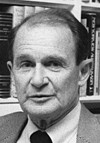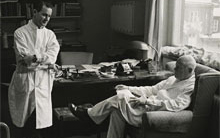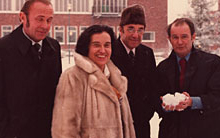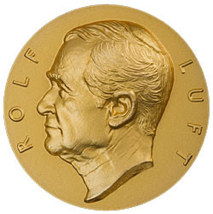Rolf Luft was born in 1914 at Södermalm in Stockholm. At the age of 26, he became a medical licentiate and licensed physician. In 1944, aged 30, he obtained his doctorate in medicine/endocrinology. In 2007, he passed away, aged 93.
In 1947, Rolf Luft went to the United States to see how endocrinology developed after the war years. He was offered a position at Harvard University but instead decided to go home and build up the field of endocrinology in Sweden. Endocrinology refers to the study of hormonal diseases, where diabetes is the most common hormonal disease.
In 1958, Rolf Luft got his own clinic at Karolinska Hospital in Solna. The clinic was paid for by Knut and Alice Wallenberg’s foundation, which, on the 100th anniversary of the foundation’s formation, decided to give Rolf Luft’s operations their biggest grant to date, 1 million Swedish kronor (equivalent to about 20 million SEK today). The clinic had its own health clinic, reception and quite soon a research laboratory in close proximity to the clinic. In 2008, the clinic celebrated its 50th anniversary.
Professor Rolf Luft
In 1961, Rolf Luft became professor of endocrinology, the first in Sweden. Rolf Luft has made many ground-breaking discoveries in endocrinology, which have improved diagnostics and treatment of patients.
One of Rolf Luft’s major and distinctive and pioneering efforts in diabetes research and diabetes care has been the first national care program for diabetics, to prevent and treat complications (sequelae caused by diabetes). Rolf Luft was very early in trying to slow the progression of serious diabetes complications, for example by reducing the production of growth hormone. He was an inspiring teacher of candidates and aspiring specialists and supervised a large number of PhD students, many of whom became prominent in endocrinology including diabetology.
During the years 1961 and 1964, Rolf Luft was chairman of the Swedish Endocrinological Association and from 1973-1979 he was chairman of the International Diabetes Federation (IDF). For almost 20 years, Rolf Luft was a member of the Nobel Committee in Medicine (1961-80) and in the years 1976-1978 he was its chairman.
In 1973, Rolf Luft became a member of the Royal Swedish Academy of Sciences (Swedish) and for a long time he was also a member of a number of international organizations and societies. Among some can be mentioned the National Academy of Sciences of the USA, The Royal College of Physicians and the American Academy of Arts and Sciences, The Finnish Society of Arts and Letters and the Indian Academy of Medical Sciences. Rolf Luft was also an honorary member of almost all national diabetes organizations in the world. He was also awarded an honorary doctorate at the universities of Salamanca (Spain), Ulm (Germany) and Toronto (Canada).
Good care on the patient’s terms
A person who is ill must have a chance to take responsibility for his illness himself. And care must be met with increased understanding by doctors and nurses who are trained diabetes educators. (Rolf Luft)
Sweden’s diabetics, and likewise today’s Swedish diabetes care, have much to thank Rolf Luft for. He was the one who ensured that the diabetes nurses receive proper training through the diabetes care program. “Good care on the patient’s terms” is also the goal of the County Council’s education center for diabetes (LUCD in Swedish), which was founded by Rolf Luft in the late 70s.
Important research discoveries
For his research on diabetes, Rolf Luft has received a series of large grants, which have led to research successes. These successes have, among other things, meant significant improvements in the living conditions of patients with diabetes. Rolf Luft was the first to show that beta-cell release of insulin depends on heredity (1963) and that stress hormones impair diabetes control (1958).
In 1958, Rolf Luft examined a woman with a disease never before described. She was sweating so profusely that she was forced to change her clothes several times a day. She consumed 3,500 kilocalories a day, despite weighing only 40 kg. The investigation led Rolf Luft to study a “particle” in the cells that controls the body’s energy production, ie the mitochondria. He found that in this woman these had lost the ability to supply the body with the energy it required for its work. The use of energy in the form of heat could not be controlled. The excess energy was released by the body through sweating. This was the first description of a disease in a cell particle/component. It came to be called Luft’s disease. This observation opened a whole new field in medicine that was later named mitochondrial medicine. Today there are more than 100 diseases that depend on changes in mitochondrial function. Current research in the field has shown that our most common age-related conditions may have something to do with the mitochondria, including Parkinson’s disease and diabetes.
Groundbreaking papers on Mitochondrial Medicine were published in 1959 and 1962, and Mitochondrial Medicine hereby became a new concept. From 1950 to the beginning of the 90s, Rolf Luft made another series of important discoveries in mitochondrial research. In 1988, a breakthrough came, when it was found that a number of diseases are caused by imbalances in the oxidation process and that this can also be the case with diabetes.
International Diabetes Federation
From 1973 to 1979, Rolf Luft was chairman of the International Diabetes Federation (IDF), an association of diabetes organizations from around the world. During his presidency, Rolf Luft visited all the countries that were part of the IDF, including the majority of developing countries. Among other things, he spread knowledge about how, by improving the education of patients and caregivers, the complications of diabetes can be reduced. Diabetes care in the world received a major boost during this time. Rolf Luft ended his presidency by reorganizing the entire IDF, which meant investing in the training of healthcare personnel and information for diabetes patients among the member organizations. Today, Rolf Luft is an honorary member of almost all national diabetes organizations in the world.
Rolf Luft Research Center for Endocrinology and Diabetology
In 1989, Rolf Luft’s Research Center for Diabetes and Endocrinology was inaugurated in a new building on the grounds of Karolinska Hospital. This activity has expanded and today includes approximately 80 researchers, including doctoral students. The center, which today is the core of the Diabetes Center Karolinska, has a large breadth of research, from molecular biology and genetics to clinical research on the causes and treatment of complications and new treatment strategies; prevention, late complications and epidemiology in type 2 diabetes.
Rolf Luft – one of the founders
Together with Professor Kerstin Brismar, Professor Rolf Luft is the founder of the Rolf Luft Foundation for Diabetes Research. Due to Rolf Luft’s successful research into diabetes and his efforts that have improved the living situation for diabetics in Sweden and the rest of the world, the foundation is named after him.
Rolf Luft was a respected and popular speaker both nationally and internationally until his death on May 22, 2007.
Read more about the Rolf Luft Award here.
An interview with Rolf Luft by Gunilla Myrberg about diabetes (in Swedish).
An interview with Rolf Luft by Gunilla Myrberg about his upbringing (in Swedish).





